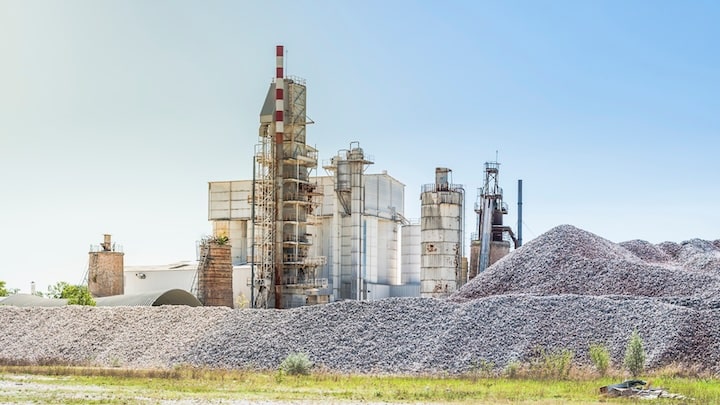This website uses cookies as well as similar tools and technologies to understand visitors’ experiences. By continuing to use this website, you consent to Columbia University’s usage of cookies and similar technologies, in accordance with the Columbia University Website Cookie Notice.
Industry Decarbonization Fact Sheet
Fact Sheet by Chris Bataille • August 17, 2022
This fact sheet represents the research and views of the author. It does not necessarily represent the views of the Center on Global Energy Policy. The piece may be subject to further revision.
Contributions to SIPA for the benefit of CGEP are general use gifts, which gives the Center discretion in how it allocates these funds. More information is available at Our Partners page. Rare cases of sponsored projects are clearly indicated.
Greenhouse gas (GHG) emissions from industrial operations are a big and growing problem that has historically seen little attention. Electricity use, heat needs (varying from 50–1,600°C [122–2,912°F]), and chemical process carbon dioxide (CO2) (e.g., from cement, lime, hydrogen, and other chemical production) create the largest amount of such emissions, as shown in Figure 1.
Figure 1: Global industrial greenhouse gas sources by sector, 2019

Until the Paris Agreement was adopted in 2015, industrial GHG mitigation was focused on energy efficiency, coal-to-gas or electricity fuel switching, and carbon capture and storage (CCS). Mitigation generally stopped at the reduction of GHG emissions by roughly 50 percent by 2050. The Paris Agreement changed everything: its emphasis on keeping the global temperature increase “well below 2°C and toward 1.5°C” shifted the global CO2 and GHG targets to net zero by 2050 and 2070, respectively. In a world meeting the Paris targets, any industrial facility still emitting CO2 in 2050 will likely have to pay for additive, permanent, and verifiable atmospheric carbon dioxide removal (CDR) offsets at the prevailing price. The latest Intergovernmental Panel on Climate Change (IPCC) report[1] has shown industrial deep decarbonization is possible but would require a set of interlocking strategies, described in Figure 2 and expanded below.
Figure 2: Strategies for decarbonizing industry

- Material efficiency through better design and building code revisions. Using best global practices incorporating GHG intensity along with other design goals for vehicles, machinery, buildings, and infrastructure could reduce cement use up to 26 percent and steel by 40 percent.
- More material circularity, initially through much more and higher quality recycling. Such efforts will be central to reducing emissions from most metals and plastics, and eventually a wider set of chemicals and concrete aggregates, among other materials.
- Energy efficiency at the point of end use and as integrated process systems. This strategy can range from using industrial heat pumps for low grade heat (up to 150°C) to better integration of processes to reduce overall heat requirements—for example, with continuous casting of iron and steel products.
- Fuel switching for existing processes. Where technically and economically feasible, most coal-to-gas switching has already occurred. A significant GHG benefit could be derived from reducing upstream fugitive methane emissions to less than 0.5 percent from current levels, which vary widely by region—for example, from 0.2 percent in British Columbia to 7–9 percent in the Permian Basin of the Southwest United States. Another key area for fuel switching is clean electrification for heat, with some interim replacement of fossil methane gas with low GHG bio or synthetic methane, also known as “renewable natural gas.” Many forms of electrification for industry are possible today, directly through electrothermal or induction heating or indirectly through industrial heat pumps, which can reach up to 150°C, with efficiencies up to 400 percent at lower temperatures. Heat pumps are generally more expensive than using natural gas or coal directly for low heat levels, however, and electrification at higher temperatures can impose challenging time-specific capacity needs on the electricity grid.
- Process changes to allow use of zero-emissions fuels and feedstocks. Fundamental changes to steel, chemical, and other material production are being commercially piloted that will allow use of clean electricity, hydrogen, low GHG carbon, and combinations thereof to be used as replacements for methane and coal for delivering heat and for chemical reactions.
- Carbon management (e.g., flue gas CO2 capture, utilization of waste CO2, sourcing of lower GHG carbon sources like biomass and direct air capture, and permanent geological storage). This will be necessary for several sectors and legacy assets, especially cement process CO2 emissions. “Drop-in” synthetic net-zero GHG liquid and gaseous fuels and feedstocks made with low-GHG carbon, hydrogen, and oxygen can replace current fossil fuels and are commercially feasible but are considerably more expensive.
Carbon capture and utilization and permanent geological storage, hydrogen made from methane and CCS (“blue”) or electrolysis (“green”), electrification, and waste heat cascading and reuse with heat pumps will all be easier to supply economically if facilities are located closer together. Such proximity could possibly occur in preplanned and approved net-zero industrial clusters, such as at seaports with existing refineries and their hydrogen needs.
If accomplished, decarbonization of industry will lead to several benefits beyond slower climate change. Along with electrifying personal transport and buildings, industrial decarbonization will help dramatically improve air quality, reducing some of the 5.9–7.5 million early deaths globally each year due to poor local air quality.[2]
Policy Considerations
Policy makers seeking pathways toward industrial decarbonization could consider the following options:
- Enact policies to ensure a large, growing, reliable, and relatively inexpensive supply of very low GHG electricity.
- Speed up the process of innovation and early-to-late commercialization for near-zero-emissions technologies to reduce production investment risk, with a focus on establishing lead markets (e.g., through government and private green procurement or targeted and dynamic subsidies, such as with contracts that provide a minimum price for a limited number of tons for a limited time).
- Establish physical industrial clusters to reduce the cost of blue and green hydrogen and CCS, and to allow waste heat reuse with industrial heat pumps.
- Implement policies to drive broad market uptake of near-zero industrial options, including: loans and tax credits to alleviate CAPEX-heavy investments, like for heat pumps; GHG standards for heat and steam; carbon pricing; and performance regulations.
- Establish international coordination regarding green procurement, GHG accounting, trade policies (e.g., border carbon adjustments and standards to make sure imports face similar climate policy stringency as domestic production does), and technology transfer and finance for developing countries, where most new demand and investment will be.
Notes
[1] IPCC, Climate Change 2022: Mitigation of Climate Change, April 4, 2022, ch. 11, https://www.ipcc.ch/report/ar6/wg3/.
[2] R. Fuller et al., “Pollution and health: a progress update,” The Lancet Planetary Health 6, no. 6 (June 2022): E535–E547, https://www.thelancet.com/journals/lanplh/article/PIIS2542-5196(22)00090-0/fulltext; IEA, Energy and Air Pollution: World Energy Outlook Special Report, June 2016, https://www.iea.org/reports/energy-and-air-pollution.
Relevant
Publications
Six Key Issues That Defined Climate Week 2025
CGEP scholars reflect on some of the standout issues of the day during this year's Climate Week

India’s Ambitious Green Steel Plan Hinges on Mitigating Coal
Amid plans to nearly double its steel production capacity by 2030 to serve its growing infrastructure needs, the world’s No. 2 steel producer India has released plans to reduce greenhouse gases from the sector, which account for about 10 percent of the nation’s total emissions.

Triggering Investment in First-of-a-Kind and Early Near-Zero Emissions Industrial Facilities
This report explores financial policy instruments that can make first-of-a-kind (FOAK) near-zero emission industrial facilities viable.



